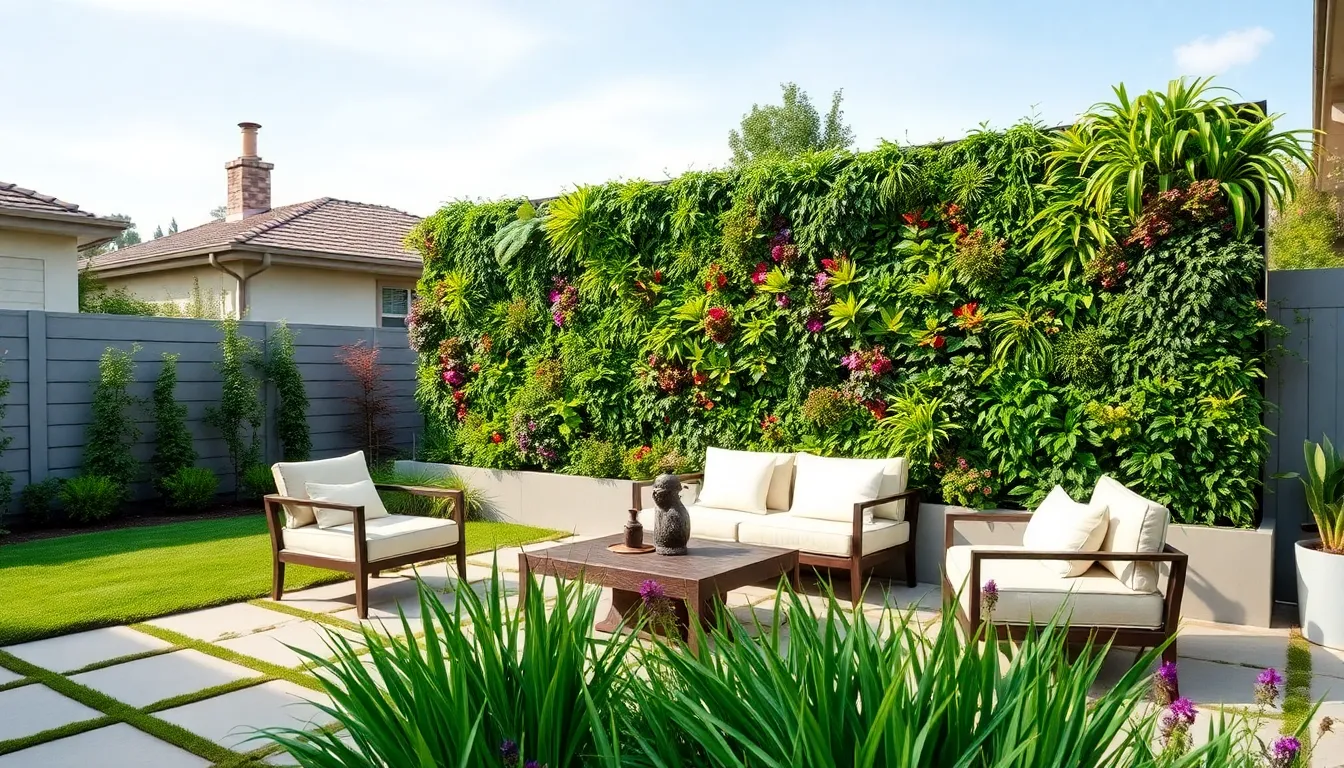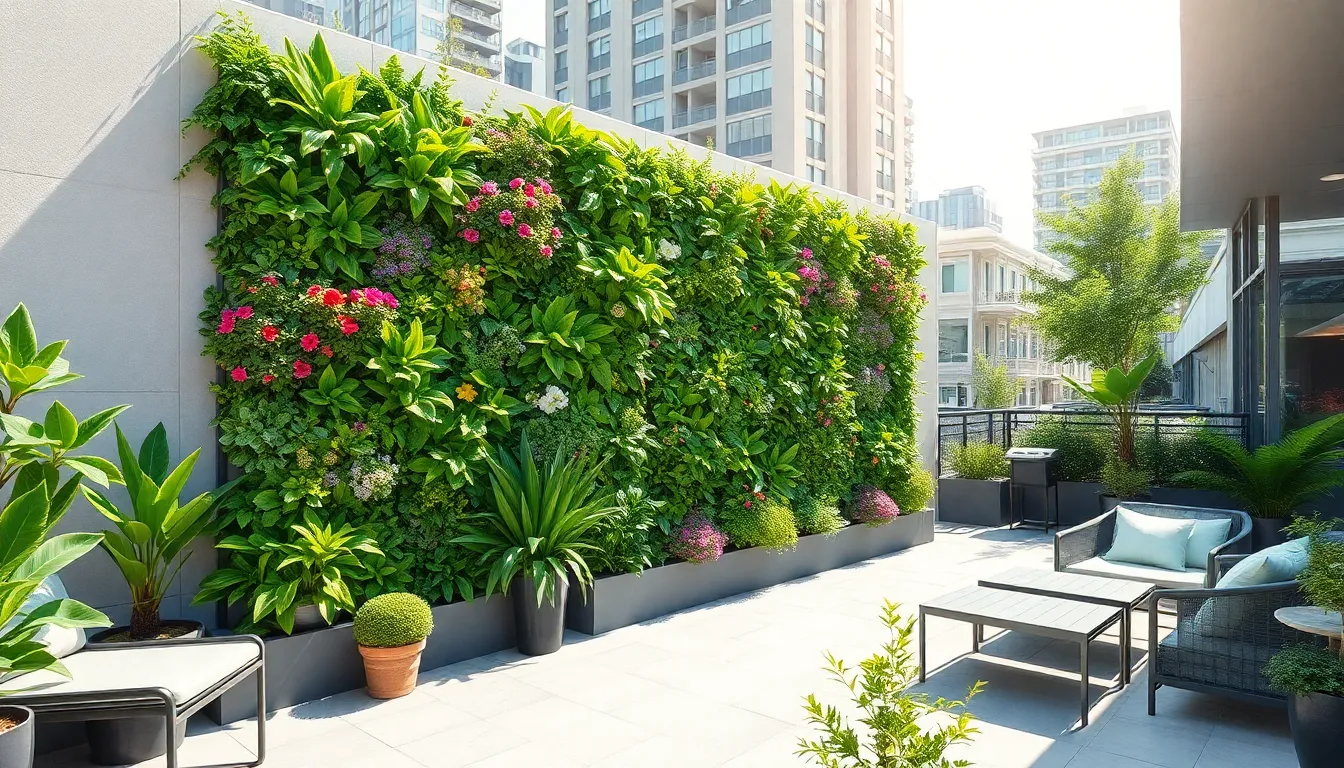Imagine transforming a dull outdoor space into a vibrant oasis where nature meets design. An outdoor living wall does just that, turning vertical surfaces into lush gardens that breathe life into any area. It’s not just a pretty face; these green masterpieces offer benefits like improved air quality and reduced noise pollution. Who wouldn’t want to enjoy a slice of paradise right in their backyard?
Outdoor Living Wall
An outdoor living wall features a vertical garden that thrives in outdoor spaces. This installation showcases an array of plants, flowers, and greenery, transforming traditional walls into lush landscapes. Designed for aesthetic appeal and environmental benefits, these walls contribute to home beauty while enhancing air quality.
The structure integrates various plant species, allowing diverse colors and textures to flourish. Many outdoor living walls also utilize innovative irrigation systems. These systems ensure that each plant receives the necessary moisture while conserving water efficiently.
Outdoor living walls are adaptable for both residential and commercial settings. They can serve as privacy screens, acting as natural barriers that enhance outdoor areas while providing seclusion. Environments with outdoor living walls often experience reduced noise pollution, creating peaceful retreats in busy locations.
Installation can occur on any solid surface. Many choose to incorporate living walls into patios, courtyards, or garden areas. Additionally, these walls offer opportunities for urban gardening, allowing individuals in apartments to grow vegetables and herbs.
Benefits extend beyond appearance, as outdoor living walls actively contribute to the ecosystem. By improving air quality, they help filter pollutants, promoting a healthier living environment. When strategically chosen, plants can also attract beneficial insects, encouraging biodiversity.
Outdoor living walls exemplify a sustainable approach to landscaping. Homeowners and businesses can reap the rewards of a stylish outdoor feature with practical advantages. Exploring local plant species ensures that the installation thrives in the specific climate, further enhancing its ecological impact.
Benefits of Outdoor Living Walls

Outdoor living walls offer numerous advantages that enhance both aesthetics and functionality in outdoor spaces.
Aesthetic Appeal
Outdoor living walls instantly elevate the visual appeal of any space. Vibrant greenery adds a natural touch to patios and gardens. Unique plant combinations create striking focal points. Textures from various plants enhance visual interest. Seasonal changes in foliage deliver dynamic beauty throughout the year. With thoughtful design, these installations harmonize with various architectural styles, bringing life to otherwise dull surfaces.
Environmental Impact
Living walls play a critical role in improving air quality. They filter pollutants and absorb carbon dioxide, resulting in cleaner outdoor environments. These walls provide habitats for pollinators and beneficial insects, fostering local biodiversity. Additionally, they help regulate temperatures, reducing the urban heat island effect. Sustainable wall systems also contribute to stormwater management by absorbing excess rainwater, which minimizes runoff. By choosing native plants, one can further enhance ecological benefits.
Space Optimization
Space optimization stands as a key benefit of outdoor living walls. Vertical gardens maximize limited areas, making them ideal for urban settings. Small backyards gain functionality and beauty without sacrificing floor space. These installations serve multiple purposes, including acting as privacy screens and sound barriers. For apartment dwellers, they offer practical solutions for growing herbs and vegetables in confined spaces. Efficient irrigation systems ensure plants thrive while using minimal resources.
Types of Outdoor Living Walls
Outdoor living walls come in various designs, each offering unique features and benefits. Understanding these types can aid in selecting the perfect fit for any outdoor space.
Green Walls
Green walls feature a diverse array of plants that grow directly on a vertical surface. These installations often use soil or hydroponic systems to support plant life. They offer extensive versatility, allowing homeowners to incorporate herb gardens, ornamental flowers, and native plants. Green walls contribute to better air quality by filtering pollutants and absorbing carbon dioxide. Additionally, they attract pollinators, enhancing local biodiversity.
Vertical Gardens
Vertical gardens emphasize aesthetics with layered plant arrangements that create stunning visual displays. These gardens use various plant species, which can be tailored to specific climates. Outdoor spaces become tranquil retreats as vibrant colors and textures transform stark walls into living canvases. Efficient irrigation systems keep plants healthy while requiring minimal maintenance. Such gardens also serve as natural sound barriers, reducing noise pollution in urban environments.
Modular Systems
Modular systems consist of pre-planted modules that are easy to install and rearrange. These systems often feature lightweight materials, making them suitable for different surfaces. They allow users to customize designs quickly, adapting layouts to fit diverse spaces. Sustainability comes into play as modular systems often incorporate recyclable materials. With minimal installation effort, these systems provide an excellent way to enhance outdoor areas with greenery.
Designing Your Outdoor Living Wall
Creating an outdoor living wall involves thoughtful planning and design. The right components ensure the wall thrives while enhancing the outdoor space.
Choosing the Right Plants
Select plants that suit the local climate and growing conditions. Native species thrive with minimal maintenance, making them ideal for outdoor living walls. Consider using a mix of flowering plants and greenery for visual interest. Herbs like basil and thyme not only beautify but also provide culinary benefits. Incorporate trailing plants to create a dynamic vertical display. Research plant compatibility to ensure that different species coexist harmoniously. This diversity enhances the wall’s ecological benefits while maintaining aesthetic appeal.
Selecting a Location
Identify a location with adequate sunlight for plant growth. Most outdoor living walls benefit from at least six hours of sunlight daily. Ensure easy access for maintenance and watering. Proximity to a water source simplifies irrigation tasks. Consider the wall’s visibility; a prominent position maximizes its visual impact. Assess wind exposure; sheltered spots protect delicate plants from harsh conditions. Evaluate existing structures and natural elements to optimize the wall’s orientation and placement.

Maintenance Considerations
Schedule regular maintenance tasks to keep the living wall healthy. Inspect plants for pests and diseases; early detection is crucial for management. Watering needs vary between species, so monitor moisture levels. Use an irrigation system that allows for efficient water distribution. Pruning promotes healthy growth and maintains aesthetics by removing dead foliage. Fertilize regularly for nutrient replenishment. Plan seasonal adjustments, swapping out plants as needed to adapt to changing weather conditions.
